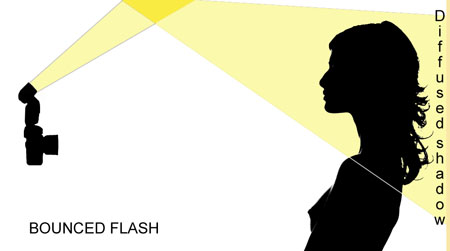 Bounced flash offers a more effective method of illuminating a subject but inevitably requires a more powerful and sophisticated flash unit. The output from a flash unit is projected at a reflector rather than directly at a subject, and is consequently diffused and scattered. This diffused light produces a much softer effect because light strikes the subject from countless different directions and so tends to fill shadow areas to some extent. The harsh shadows produced by direct flash are not normally apparent.
Bounced flash offers a more effective method of illuminating a subject but inevitably requires a more powerful and sophisticated flash unit. The output from a flash unit is projected at a reflector rather than directly at a subject, and is consequently diffused and scattered. This diffused light produces a much softer effect because light strikes the subject from countless different directions and so tends to fill shadow areas to some extent. The harsh shadows produced by direct flash are not normally apparent.
The nature of the surface from which the flash output is bounced has a considerable bearing upon the result achieved. For most purposes, a plain white surface such as a ceiling may be desirable. This reflects much of the light which strikes it, and the direction of the reflected light can be predicted to a large extent. Coloured surfaces reflect light bearing the hue of the reflecting surface, so a blue ceiling will reflect blue light and give the whole scene a bluish tint.
A similar fill effect can be achieved with reflectors of various types. Gold and half-gold reflectors return warm light appropriate for skin tones, whereas silver or white surfaces produce a cooler effect. Reflectors are easy to use to deflect and diffuse flash output, but it is usually necessary to employ an assistant to hold the reflector in a suitable position and orientation. In practice they may prove cumbersome and also tend to attract attention when working outdoors.
When flash is bounced from a reflecting surface, some of the light is deflected away from the subject. The output of the flashgun must therefore be increased to compensate for this. However, with through-the-lens metering it is a simple matter to obtain the correct exposure. The electronics in the flashgun simply waits until the correct amount of light has been received before turning off the flash.






